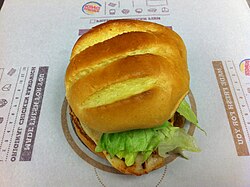Burger King grilled chicken sandwiches

The North American version of the
TenderGrill sandwich, as of November 2013. |
|
| Nutritional value per 1 sandwich (425 g) | |
|---|---|
| Energy | 510 kcal (2,100 kJ) |
|
49 g
|
|
| Sugars | 15 g |
| Dietary fiber | 0 g |
|
19 g
|
|
| Saturated | 3.5 g |
| Trans | 0.5 g |
|
37 g
|
|
| Minerals | |
| Sodium |
(79%)
1180 mg |
| Other constituents | |
| Energy from fat | 124 kcal (520 kJ) |
| Cholesterol | 75 mg |
|
May vary outside US market.
|
|
|
|
| Percentages are roughly approximated using US recommendations for adults. Source: www.BK.com (PDF) |
|
International fast-food restaurant chain Burger King and its Australian franchise Hungry Jack's have had a variety of grilled chicken sandwiches in their product portfolio since 1990. The BK Broiler was the first iteration, and was one of the most successful product introductions in the fast food industry to that point in time. However sales dropped in the following two years, and the product was reformulated and renamed to the Chicken Whopper to align the product with the company's Whopper Sandwich. A change of ownership of Burger King in 2004 prompted another reformulation of the product into the BK Baguette product line that focused on a more health-oriented product. This new formulation proved unpopular and was replaced in 2005 with the TenderGrill chicken sandwich. The TenderGrill sandwich was introduced as part of a series of sandwiches designed to expand Burger King's menu with both more sophisticated, adult oriented fare and present a larger, meatier product that appealed to 24- to 36-year-old males. Burger King was the first major fast food chain to introduce a grilled chicken sandwich to the marketplace, beating rivals Wendy's by six months and McDonald's by four years. These two chains also went through a series of reformulations and naming schemes for their grilled chicken products.
The company sells slightly different versions of the sandwich between international markets, using white meat chicken breast in some regions while using dark meat chicken thighs in others. To promote continuing interest in the product, Burger King occasionally releases limited-time (LTO) variants on its grilled chicken sandwiches that have different ingredients from the standard sandwich recipe. Being one of the company's major offerings, the grilled chicken sandwich is sometimes the center of product advertising for the company. Additionally, as a major product in the company's portfolio, Burger King has registered many global trademarks to protect its investment in the product.
Burger King's first broiled chicken sandwich was introduced in 1990 and was called the BK Broiler. This sandwich was made with lettuce, tomato and a dill ranch sauce served on an oat dusted roll. The product came at a time of fundamental change in terms of chicken product in the restaurant industry; more than 90% of chicken products sold by the major chains were fried. Shortly after its introduction, the sandwich was selling more than a million units per day, and poaching sales from traditional fried chicken chains such as Kentucky Fried Chicken. Additionally, the sandwiches were part of an industry trend towards the diversification of menus with healthier products such as reformulated cooking methods and salads. At the time, the sandwich had 379 calories and 18 grams of fat, 10 of which came from the sauce.
...
Wikipedia
